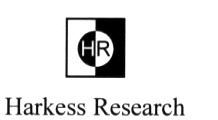
 Wisp
Unification Theory - Appendix B
Wisp
Unification Theory - Appendix B
- Home
- About Me
- Reasons why Einstein was wrong
- One-way speed of light experiments
- Hot topic
- Q&A
- ACES - The end of Relativity
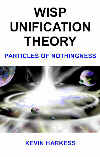
- Book Contents
- Introduction
- 1 Matter,Space and Time
- 2 Symmetry
- 3 Fractals
- 4 Wisp Space
- 5 Gravity
- 6 Electromagnetic Force
- 7 Wisp & S.R: Fundamentals
- 8 Wisp & S.R: Electrodynamics
- 9 Wisp & S.R: Doppler effect
- 10 Wisp & S.R: Relativistic Mechanics
- 11 Big bang
- Appendix A
- Appendix B
- Index A-Z
- Copyright
- Feedback
This page contains the complete appendix. To download the new 2011 2nd edition of wisp unification theory go to the homepage.
Appendix B
Fizeau’s Experiment
In 1851 Armand Fizeau performed an experiment to measure the speed of
light in moving water. Its purpose was to measure the value of the ether
drag coefficient.
He discovered that changes in the speed of light are proportional to the
water’s flow rate, and he calculated the drag coefficient to be 0.48,
a result consistent with Fresnel’s earlier prediction of 0.43.
However, it turned out that the drag coefficient predicted by Fresnel
gave a result that appears correct, but its derivation is not wholly correct.
We know that moving water does not drag wisp space along with it, but
there is some merit in Fresnel’s thought process. Both Einstein and
Fresnel have produced equations that appear to give correct predictions
for the speed of light moving through water, and we shall apply wisp’s
velocity transformations to both sets of established equations.
Wisp theory will show that there is a small difference in predicted values
caused by the Earth’s motion through wisp space.
B.1 Apparatus
Light of fixed wavelength emits from a source and strikes a half-silvered
mirror that splits it into two rays, which travels along different paths
– with and against the flow of water (Figure B.1). We draw the rays
separated for clarity to allow their individual speeds to be seen, but
in reality they would form a single ray with components travelling in
opposite directions.
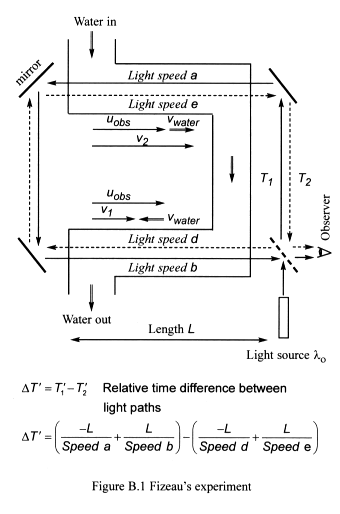
B.2 Theory
The relative speed of the water affects the speed of light ray passing
through it. As the light rays travel in opposite directions with and against
the water flow, they move at different speeds, and when recombined they
are seen to be out of step with one another – even though their wavelengths
are the same.
Altering the water’s flow speed causes the light’s interference
fringe pattern to shift.
The refractive index of water, n = 4/3, determines the speed at
which light travels through it, c/n. If water then travels at speed
through wisp space, it changes the speed at which light travels.
Water molecules create shapes in wisp space that cause light to slow down,
and when water moves its shapes displace wisps at right angles to its
motion, which affect light’s speed. Moving against the direction
of light reduces its speed further, while moving with it reduces the slowing
effect and light travels faster.
The process is complex, but it appears that both Einstein’s and Fresnel’s
equations do correctly predict the interaction of light with moving water.
Fizeau’s experiment demonstrates that the motion of water speeds
up or slows down light. Since the frequency of light leaving the source
is the same as that seen by the observer the shift in the observed fringe
pattern can only be due to light travelling at different speeds through
moving water.
B.3 Applying wisp theory to special relativity’s formula
By applying wisp’s velocity transformations to Einstein’s velocity
addition formula we can predict what affect the Earth’s motion through
wisp space has on the outcome of the experiment.
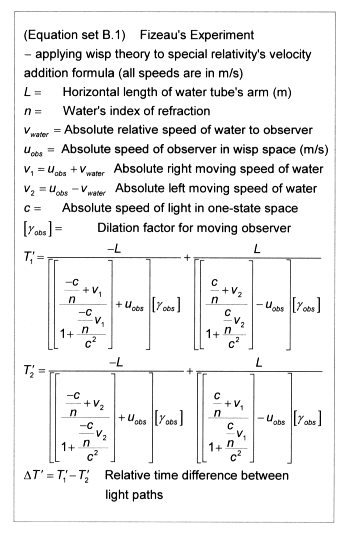
Equation set B.1 shows Einstein’s velocity addition formula expressed
in terms of wisp’s velocity transformations.
By letting the observer’s speed uobs equal zero (a limit process),
the wisp equation reduces exactly to special relativity’s equation,
as would be expected (Equation set B.2).
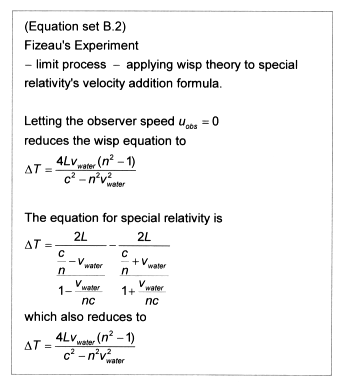
However, when we take into account the Earth’s orbital velocity (its
assumed motion through wisp space), it results in a small increase in
the time difference interval.
The ratio of wisp time to special relativity time is 1.000265, and it
stays constant for varying water speeds (assuming absolute water speeds
are small compared to the speed of light).
B.4 Applying wisp theory to Fresnel’s formula
We adapt Fresnel’s formula (Equation set B.4 – upper) to wisp
theory by referencing the speed of water to absolute wisp space and adding
the effects of time dilation.
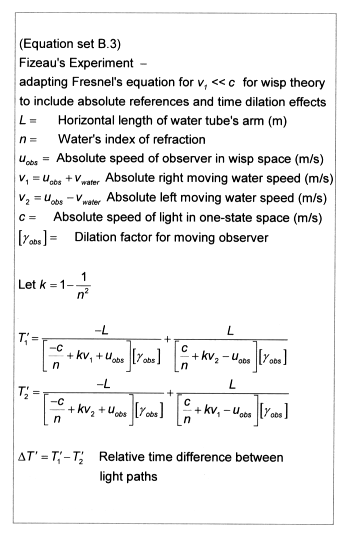
Again, when we take into account the Earth’s motion through wisp
space, it results in a small increase in the time difference interval
(Equation sets B.3 and B.4 lower).
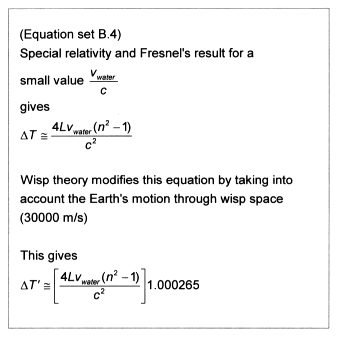
B.5 Conclusion
By applying wisp theory to established equations that appear to give a
correct prediction of the speed of light through moving water, we discover
that the Earth’s motion causes the time difference term to increase
by a small constant multiplying factor of 1.000265.
Equation set B.4 (lower) shows the corrected formula for measurements
carried out on Earth (the water’s speed measurement vwater is relative
to the Earth’s surface).
By rotating the apparatus such that both arms are perpendicular to the
Earth’s motion through wisp space the small offset effect will be
cancelled.
It might be possible to detect this offset using sensitive fringe shift
detection equipment, and using materials with a higher refractive index
– such as glass (refractive index 1.5) – to achieve better accuracy.
Glass could be rotated in cylinder form to ensure that its speed is uniformly
controlled while the light rays pass through its sides.
Home --
About Me -- Reasons
why Einstein was wrong -- One-way
speed of light experiments -- Hot
topic -- Q&A -- ACES
- The end of Relativity --
Book Contents -- Introduction
-- 1 Matter,
Space and Time -- 2
Symmetry -- 3
Fractals -- 4 Wisp Space
-- 5 Gravity -- 6
Electromagnetic Force --
7 Wisp & S.R: Fundamentals
-- 8 Wisp & S.R: Electrodynamics
-- 9 Wisp
& S.R: Doppler effect -- 10
Wisp & S.R: Relativistic Mechanics --
11 Big bang -- Appendix
A -- Appendix B -- Index
A-Z -- Copyright -- Feedback